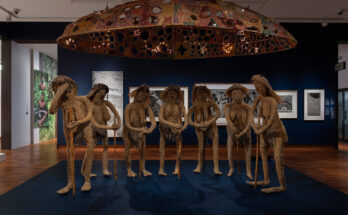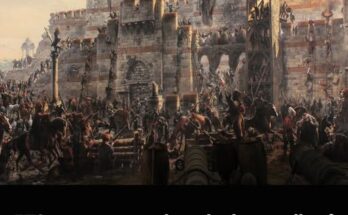Beneath the bustling modern streets of Mexico City lies a city of another time, a civilization so deeply rooted in blood, ritual, and cosmic order that it continues to astonish the world even five centuries after its fall. In recent years, archaeologists made a haunting discovery beneath what was once the ceremonial heart of Tenochtitlan, the capital of the Aztec Empire: a massive tower of human skulls, a grisly remnant of a culture defined in part by its public displays of sacrifice. But it wasn’t merely the sheer number of skulls that stirred both awe and academic curiosity—it was the presence of women and children among them.
The discovery challenged long-standing assumptions about who was sacrificed in Aztec rituals and why. Was it purely captives of war, as once thought? Or does this reveal something more complex about Aztec cosmology, gender roles, and the very nature of power and piety in a world where the divine and the violent intertwined?
This essay delves into the significance of this bone-chilling find, what it reveals about the Aztec view of the cosmos, and how it reshapes our understanding of one of the most powerful civilizations in pre-Columbian America.
A Discovery Beneath the City
In the shadow of Mexico City’s colonial cathedrals and towering office buildings, archaeologists from the National Institute of Anthropology and History (INAH) unearthed a macabre structure: a cylindrical tower, over six meters in diameter, built from hundreds of human skulls mortared together with lime. It was found near the ruins of the Templo Mayor, the most important religious complex of the Aztec Empire, dedicated to the gods Huitzilopochtli (god of war and the sun) and Tlaloc (god of rain and agriculture).
This was no ordinary tomb. The tower—known as the Huei Tzompantli, or “great skull rack”—had been known from Spanish accounts, particularly those of Hernán Cortés and Bernal Díaz del Castillo, who described a grisly spectacle of thousands of skulls displayed on horizontal poles. But many historians once dismissed these stories as colonial exaggerations. Now, with the physical evidence before us, the horror—and the cultural complexity—of the Aztec world comes into sharper focus.
The Skull Tower: Structure and Symbol
The Huei Tzompantli was not simply a grotesque mass of bones. It was architecture imbued with meaning. It was a statement to both the gods and the people. Rising near the center of Aztec ritual life, the tower served multiple purposes: it was a tribute to divine forces, a tool of social control, and a visual testament to the power of the empire.
The skulls themselves were meticulously arranged. Most bore signs of ritual decapitation, their jawbones removed, likely to ease their mounting onto wooden racks before being incorporated into the tower. They were not buried or hidden—they were put on display, offering a chilling reminder that life and death were part of a sacred cycle, and that the gods demanded repayment in flesh.
Until recently, the dominant interpretation was that the victims were captured enemy warriors—sacrificed to honor Huitzilopochtli and ensure the continued movement of the sun. But the discovery of women and children among the tower’s skulls has significantly broadened the conversation.
Women and Children in the Tower
The presence of female and juvenile remains among the skulls has sparked profound reevaluation of Aztec sacrificial practice. This wasn’t just a display of military dominance over rival city-states. It reflected a cosmology in which every human being, regardless of gender or age, could be offered to the gods, depending on the ritual’s requirements.
So why women and children?
One theory suggests that their inclusion was tied to specific deities. While men were often sacrificed to war gods like Huitzilopochtli, women and children may have been offered to agricultural or rain gods like Tlaloc, who was believed to demand the tears of children to nourish the earth. Some accounts mention children being kept in conditions that made them cry before sacrifice, ensuring their sorrow would please the god.
Other female sacrifices may have been priestesses or individuals chosen to embody goddesses in annual ceremonies. In such cases, a woman might be treated with reverence, adorned like a deity, and celebrated—only to be ritually killed at the peak of the festival.
Rather than dismissing this as simple brutality, we must view it through the lens of Aztec belief: sacrifice was an honor, a necessity, and a divine duty. Life was temporary; the gods were eternal.
The Aztec Worldview: A Universe Built on Blood
To understand the skull tower and its meaning, one must grasp the Aztec view of the cosmos. The Aztecs believed the universe had been created and destroyed multiple times in a cycle of suns or epochs. In their current era—the fifth sun—human beings had a critical role to play: they were responsible for feeding the gods, particularly the sun, through sacrifice.
This was not seen as cruelty but as reciprocity. The gods had sacrificed themselves to create the world and keep the sun in the sky. Therefore, humans owed them payment in kind. The heart, the blood, and even the head of a person were not just offerings—they were sustenance for divine beings.
Sacrifice was not random but governed by a sacred calendar. Specific days and festivals required specific types of victims, sometimes with elaborate preparation. Rituals could be accompanied by music, feasting, and processions, giving them a communal and spiritual dimension.
In this sense, the tower of skulls was not just an expression of death—it was a symbol of cosmic balance. Each skull was a brick in the foundation of the Aztec universe.
Reactions of the Spanish
When the Spanish conquistadors arrived in the early 16th century, they were horrified by what they saw. Bernal Díaz, in his The True History of the Conquest of New Spain, described enormous racks filled with skulls, some estimates numbering in the tens of thousands. To the Spaniards—steeped in Christian doctrine—these rituals were demonic, the work of the devil himself.
They saw the Aztec religious practices as justification for conquest. Hernán Cortés destroyed many of the temples, burned idols, and forced conversions to Christianity. Ironically, some of the very churches they built—like the Metropolitan Cathedral—now sit atop the ruins of temples like the Templo Mayor, physically and symbolically layering Christian domination over indigenous belief.
But modern archaeology reveals what the Spanish could not comprehend: this was not barbarity for its own sake. It was the heartbeat of a complex and deeply spiritual society, whose laws, calendars, medicine, and architecture rivaled those of Europe.
Sacrifice and Social Cohesion
It’s easy to focus solely on the violence of sacrifice, but it’s also important to consider how these rituals reinforced social order. Public ceremonies of death were not merely fear tactics—they were also moments of communal reaffirmation.
The entire city would participate in these spectacles. Nobles, priests, artisans, farmers, and warriors all had roles to play. Offerings were made; dances were performed; sacrifices were witnessed. It was a shared reaffirmation of values: loyalty to the gods, the necessity of order, and the unbreakable link between the mortal and the divine.
Even the victims may have believed they were fulfilling a sacred duty. Some were prisoners of war; others were selected specifically to honor the gods. The idea that death was not an end but a transformation into divine service gave meaning to the ultimate price.
Challenging the Stereotypes
For centuries, the Aztecs have been portrayed in the West as bloodthirsty savages. While the scale of their sacrifices cannot be denied, such portrayals often strip them of context and reduce a multifaceted civilization to a horror story.
But the discovery of the skull tower complicates this narrative. It forces us to reckon with the uncomfortable truth that religion, even in its most beautiful and sophisticated forms, can demand terrible things of its followers. And that the line between devotion and death is not always clear.
Moreover, the inclusion of women and children in the tower invites us to look beyond war and conquest and examine how Aztec society understood innocence, purity, and the sacred feminine. These were not random acts of violence—they were carefully calibrated religious rites that mirrored a worldview in which the gods were not just loving, but also insatiable.
The Living Memory of the Aztecs
Today, the Aztecs are gone, but their legacy remains. Nahuatl, the language of the Aztecs, is still spoken by over a million people in Mexico. Their descendants live in cities and pueblos, balancing modernity with ancient traditions.
The Templo Mayor excavation site now includes a museum, and the skull tower has become a place of both academic fascination and cultural memory. For some, it is a source of pride—a reminder of a civilization that stood tall before the Spanish conquest. For others, it remains a symbol of a dark and painful history.
Yet, in all its haunting grandeur, the Huei Tzompantli offers something rare: an unflinching look at a society that built its world on ritual, and that dared to put death on display not to terrify, but to sustain the universe itself.
Conclusion: Skulls as Scripture
The tower of skulls beneath Mexico City is more than an archaeological marvel. It is a message from the past—a script written in bone, a monument to a people who believed that every heartbeat echoed through the cosmos.
In the faces of those skulls—men, women, and children—we see not just victims, but believers. People who lived in a world where blood was not just a fluid, but a gift. Where the gods walked among men, demanding sacrifice not out of cruelty, but as part of an eternal pact.
It reminds us that civilization is not a straight line from savagery to progress, but a spiral of belief, power, and meaning. The Aztecs did not come to their practices lightly. They built a society where beauty and blood coexisted, and where the sacred was etched into every stone, every calendar, and every skull.
To find women and children among the tower’s remains is to realize that the divine contract extended to all. It is chilling, yes—but it is also profoundly human.
And now, as modern life unfolds above the ancient bones, the skull tower endures—not as a monument to brutality, but as a monument to belief.


